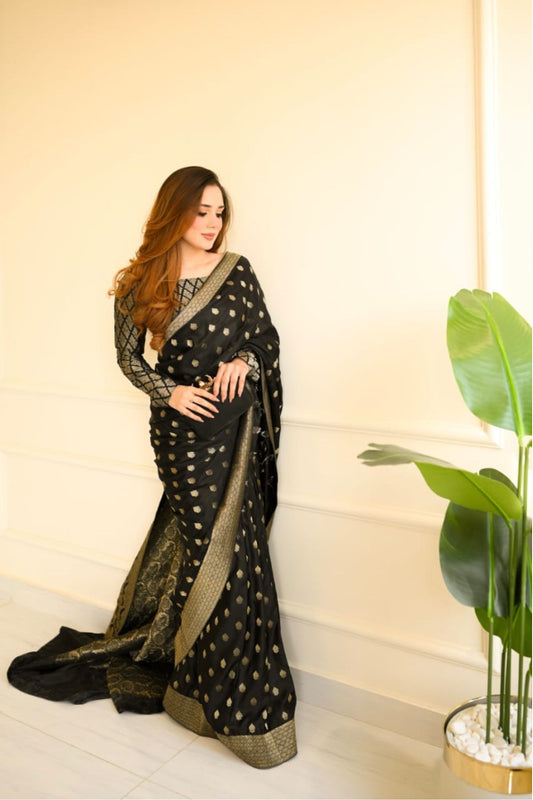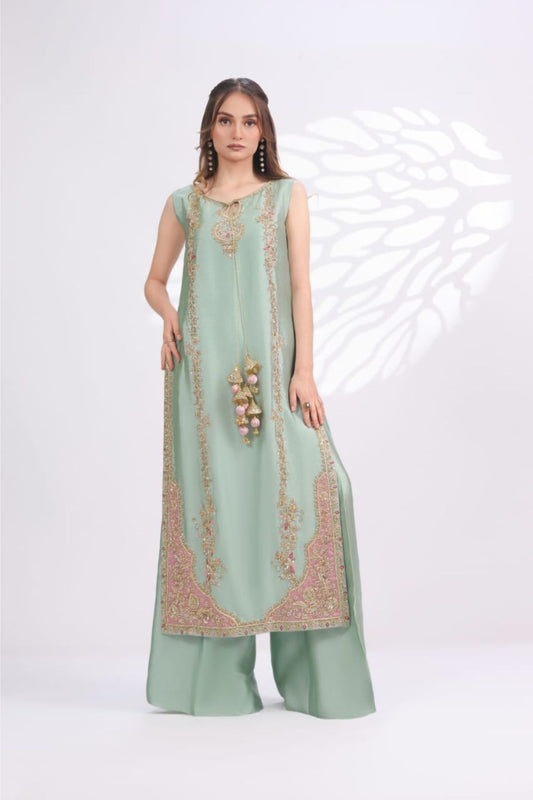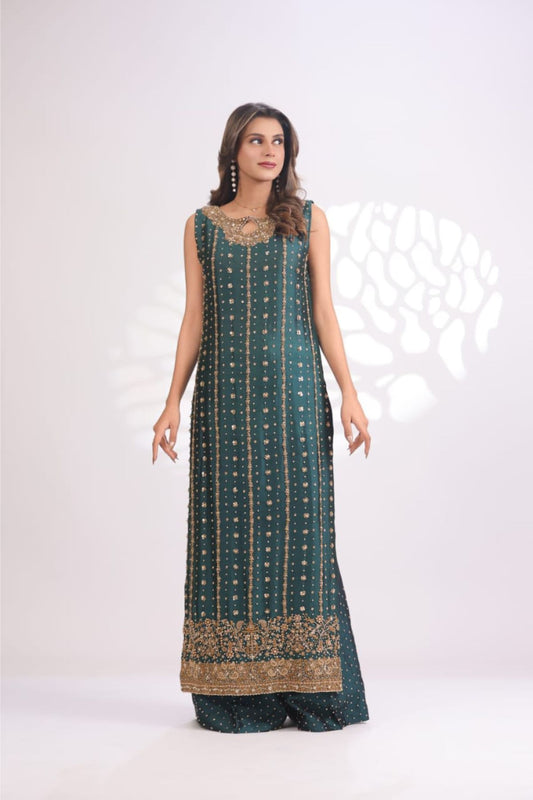Dazzling Dupattas: A Highlight of Pakistani Party Wear
Introduction
In the vibrant world of Pakistani fashion, party wear holds a special place, and one element that adds an extra layer of allure to these ensembles is the dazzling dupatta. The dupatta, a long, flowing piece of fabric worn over the shoulders, is not just an accessory but a statement piece that elevates the entire outfit. Let's delve into the enchanting world of Pakistani party wear and explore how these dazzling dupattas steal the spotlight.
The Significance of Dupattas in Pakistani Culture
In Pakistan, clothing is not merely a form of self-expression; it is deeply rooted in the country's rich cultural heritage. The dupatta, in particular, has a symbolic significance, representing grace, modesty, and tradition. When it comes to party wear, this traditional accessory undergoes a transformation, becoming a canvas for intricate embellishments, vibrant colors, and exquisite craftsmanship.
Embellishments and Embroidery
Embroidery and embellishments play a pivotal role in transforming a simple piece of fabric into a work of art, especially when it comes to Pakistani party wear dupattas. Let's explore the significance and techniques behind the meticulous embellishments and embroidery that adorn these dazzling accessories:
Zardozi:
Zardozi is an elaborate and time-honored form of embroidery that involves the use of metallic threads, usually gold or silver, along with beads and precious stones. This technique imparts a regal and opulent look to the fancy dress dupatta. Zardozi work is often intricate, with skilled artisans meticulously hand-stitching the metallic threads to create elaborate patterns and motifs.
Gota Work:
Gota work is a traditional form of embellishment that originated in South Asia. It involves the use of narrow ribbons or strips of gold or silver-coated metallic fabric, known as 'gota,' which are sewn onto the base fabric. Gota work is often used to create borders, floral patterns, and intricate designs, adding a touch of glamour and richness to the dupatta.
Threadwork:
Threadwork is a versatile embroidery technique where colorful threads are used to create intricate patterns on the fabric. It can range from simple floral motifs to more complex designs. Threadwork allows for a wide variety of colors and textures, making it a popular choice for adding vibrancy and depth to Pakistani party wear dupattas.
Sequins:
Sequins are small, shiny discs that are sewn onto the fabric of a formal dress to create a sparkling effect. They are often used in conjunction with other embroidery techniques to enhance the overall glamour of the dupatta. Sequins can be arranged in specific patterns or scattered across the fabric, catching and reflecting light to create a dazzling and eye-catching appearance.
Mirror Work:
Mirror work, also known as shisha embroidery, involves the use of small pieces of mirror or reflective material. These mirrors are carefully embedded into the fabric, often in geometric or floral arrangements. Mirror work adds a distinctive and captivating element to the dupatta, creating a play of light and enhancing its visual appeal.
Resham Embroidery:
Resham, or silk thread, embroidery involves the use of silk threads to create intricate patterns and designs. This form of embroidery is known for its smooth texture and vibrant colors. Resham embroidery can range from delicate and subtle to bold and eye-catching, offering a wide range of design possibilities for Pakistani party wear dupattas.
Vibrant Colors and Luxurious Fabrics
The combination of vibrant colors and luxurious fabrics is a hallmark of Pakistani party wear, contributing to the allure and visual appeal of the attire. Let's delve into the significance of these elements:
Bold and Vibrant Color Palette:
Pakistani party wear is renowned for its fearless embrace of bold and vibrant colors. These hues not only add energy and vivacity to the ensemble but also play a crucial role in expressing the celebratory and festive nature of the occasions for which these outfits are designed. The color palette often includes rich jewel tones such as deep blues, emerald greens, regal purples, and striking reds, creating a visually stunning impact.
Variety of Colors:
The diversity of colors used in Pakistani party wear reflects the rich cultural tapestry of the region. Depending on the occasion, regional influences, and personal preferences, designers incorporate a wide range of colors into the dupatta. Pastel shades are often chosen for daytime events, while bold and saturated colors are preferred for evening and festive occasions, ensuring a dynamic and versatile range of choices for individuals.
Riot of Colors in Dupattas:
Dupattas, being a significant part of the overall attire, often showcase a riot of colors. They can feature intricate patterns and designs, with multiple hues seamlessly blended or juxtaposed. The use of contrasting colors and complementary shades enhances the visual appeal of the dupatta, making it a focal point of the entire ensemble.
Luxurious Fabrics:
The choice of fabric is paramount in defining the quality and richness of Pakistani party wear, and luxurious fabrics are favored for their ability to elevate the overall look. Silk, chiffon, and organza are among the most commonly used fabrics for dupattas. Each fabric brings its unique characteristics to the table.
Silk:
Silk is a symbol of opulence and elegance. Dupattas made from silk have a luxurious sheen and a smooth texture. Silk drapes beautifully and adds a regal touch to the attire, making it a popular choice for special occasions and celebrations.
Chiffon:
Chiffon is known for its lightweight and airy quality. Dupattas made from chiffon have a flowing and ethereal appearance. The fabric allows for intricate detailing in embroidery and embellishments while maintaining a graceful and delicate drape.
Organza:
Organza is a sheer and crisp fabric that adds a touch of sophistication to dupattas. It provides a structured yet lightweight look, allowing for intricate embroidery and embellishments to stand out. Organza dupattas often contribute to a contemporary and modern aesthetic.
Versatility in Styling
Versatility in styling is a key feature that makes the dupatta a standout element in Pakistani party wear. The ability to drape the dupatta in various ways allows individuals to customize their look based on the occasion, personal style preferences, and the design of the outfit. Here's a closer look at the versatility in styling that makes the dupatta a highlight:
Classic Over-the-Shoulder Drape:
The traditional and most common way of wearing a dupatta is the classic over-the-shoulder drape. In this style, the dupatta is gracefully draped over both shoulders, allowing it to fall down the back. This style is timeless, adding an elegant and sophisticated touch to the overall ensemble. It is often chosen for formal events, weddings, and traditional celebrations.
Trendy One-Sided Drape:
For a contemporary and stylish look, individuals often opt for the trendy one-sided drape. In this style, the dupatta is thrown over one shoulder, creating a cascading effect down the front or back. This asymmetric and fashionable drape is particularly popular among younger generations and is well-suited for modern party wear outfits.
Regal Double Drape:
The regal double drape involves using two dupattas, each draped in a distinct manner. One dupatta can be worn traditionally over the shoulders, while the other may be draped across the arms or waist, creating a layered and regal appearance. This style is often chosen for grand events, weddings, and formal gatherings where a more elaborate look is desired.
Innovative Draping Techniques:
The versatility of the dupatta extends to various innovative draping techniques. Some individuals prefer to experiment with unconventional styles, such as looping the dupatta around the neck, creating a cape-like effect, or using it as a headscarf for a more modest look. These creative draping techniques allow for individual expression and add a contemporary twist to traditional attire.
Front Pallu Drape:
In a departure from the traditional over-the-shoulder drape, some individuals choose to drape the dupatta across the front, creating a front pallu. This style allows for the display of intricate embroidery and embellishments on the dupatta's front, making it a focal point of the outfit.
Belted Dupatta:
Adding a belt to the dupatta is another stylish way to enhance the overall look. The belt can be worn at the waist, creating a cinched effect and giving the outfit a modern and structured appearance. This style is often seen in contemporary party wear outfits.
Regional Influences
Pakistani fashion is a melting pot of diverse regional influences, each contributing to the uniqueness of party wear. From the vibrant and intricate Phulkari work of Punjab to the subtle and delicate Chikankari of Lucknow, the regional embroidery styles find their way into the design of dupattas, creating a beautiful fusion of traditions.
Conclusion
In the world of Pakistani party wear, the dupatta stands out as a true masterpiece, weaving together tradition, craftsmanship, and contemporary design. Whether attending a wedding, a festive celebration, or a social gathering, the dazzling dupatta adds the perfect finishing touch, making every wearer feel like royalty. As Pakistani fashion continues to evolve, the enchanting allure of party wear dupattas remains a timeless and integral part of the cultural tapestry.






